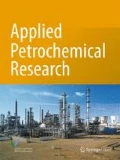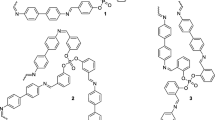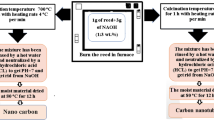Abstract
A Schiff base containing the 1,2,4-triazole moiety was synthesized and added to polystyrene at low concentration for a homogenous blend. The polystyrene film was irradiated with ultraviolet light and the surface morphology was analyzed. Micrographs of the polystyrene/Schiff base blend after irradiation indicated the fabrication of a terrestrial crack-like material. This was ascribed to the presence of the Schiff base, relatively long irradiation time, and photostability induced by the base. After irradiation, the blank polystyrene film formed a cotton-like fibrous material.
Similar content being viewed by others
Introduction
Polystyrene (PS) is a typical plastic used in applications such as food packaging [1]. PS can be mixed with additives or colorants to be used in toys, electronics, and appliances [2, 3]. PS is inert and resists both alkaline and acidic environments; moreover, it has low production cost and low weight. PS is used in various commercial applications [4]. The crystallinity of PS is dependent on the arrangement of phenyl moieties along the polymer chains [5]. The most common types of PS are atactic and syndiotactic. The first one has amorphous structure where the phenyl groups are randomly arranged and is commercially important [1]. The syndiotactic PS is crystalline where the phenyl groups alternatively arranged on both sides of the polymer chains [1]. PS is not biodegradable, and deteriorates under prolonged exposure to sunlight. Therefore, its mechanical, physical, and chemical properties require improvement for it to last longer, particularly in outdoor applications.
The photodegradation of PS in the presence of oxygen causes deterioration of both, mechanical and physical properties; this leads to discoloration, crack formation, and brittleness [6, 7] Additives to the PS matrix can enhance the photostability of the polymeric chains against photo-irradiation. Colorants, stabilizers, and plasticizers can act as UV absorbers and stabilizers, and therefore protect PS upon exposure to irradiation [8, 9]. Various PS additives containing aromatics [10], heterocycles [11], and metal complexes [12] have been used to reduce the rate of photodegradation. Such additives act as flame retardants, antioxidants, quenchers, UV absorbers, and radical scavengers [13,14,15,16,17].
Herein, the successful fabrication of an ordered porous PS material doped with a Schiff base containing the 1,2,4-triazole moiety, after irradiation with ultraviolet light (UV) for 300 h was reported. The Schiff base chosen is novel, easy to synthesize, highly aromatic and incorporates phenyl, benzyl, a meta-substituted aryl ring, and 1,2,4-triazole, which provide all the necessary elements for a good photostabilizer. Heterocycles containing the 1,2,4-triazole moiety have various biological activities [18,19,20,21]. The Schiff base enhances the photostability of PS against photodegradation that is a continuation of previously reported work in the area of polymers [22,23,24,25,26,27,28,29,30,31,32,33]. The elemental composition of the PS films was measured by energy-dispersive X-ray (EDX) spectroscopy, and the surface morphology was analyzed by scanning electron microscopy (SEM) and atomic force microscopy (AFM).
Materials and methods
General
PS, chemicals and reagents were obtained from the Sigma-Aldrich Chemical Company (Gillingham, UK) and used without further purification. Fourier transform infrared (FTIR) spectra were recorded on a Jasco FT/IR-4200 spectrometer (Tokyo, Japan). The Varian Mercury-300 spectrometer (Varian, Mundelein, Illinois, USA) was used to record proton nuclear magnetic resonance (1H NMR) spectra. The morphology of the PS films was examined with an Inspect S50 microscope (FEI Company, Czech Republic). Bruker XFlash® 6|10 (Bruker, Tokyo, Japan) was used to measure the EDX patterns. Atomic force microscopy (AFM) of the PS was inspected using Veeco instrument (Plainview, NY, USA).
Synthesis of (E)-ethyl 2-[(4-(benzylideneamino)-5-phenyl-4H-1,2,4-triazol-3-ylthio]acetate (2)
Ethyl 4-chloroacetoacetate (0.74 g, 4.5 mmol) was added to a solution of 1 (0.84 g, 3.0 mmol) in ethanol (20 mL) containing K2CO3 (0.41 g, 3.0 mmol). The mixture was reflexed for 3 h and the solid obtained was filtered and recrystallized from ethanol to give 2.
Synthesis of (E)-2-[(4-(benzylideneamino)-5-phenyl-4H-1,2,4-triazol-3-ylthio]acetohydrazide (3)
Hydrazine hydrate (0.37 g, 11.0 mmol) was added to a solution of 2 (2.56 g, 7.0 mmol) in ethanol (25 mL). The mixture was refluxed for 3 h and the solid produced was filtered and recrystallized from ethanol to give 3.
Synthesis of (E)-2-{(4-[(E)-benzylideneamino]-5-phenyl-4H-1,2,4-triazol-3-ylthio}-N’-(3-nitrobenzylidene)acetohydrazide (4)
A mixture of 3 (1.76 g, 5.0 mmol) and 3-nitrobenzaldehyde (0.91 g, 6.0 mmol) in ethanol (10 mL) containing glacial acetic acid (0.2 mL) was refluxed for 4 h. The solid obtained was filtrated and recrystallized from ethanol to give 4.
Preparation of PS films
Schiff base 4 (25 mg) was added to a stirred solution of PS (5.0 g) in chloroform (100 mL) and stirred for 90 min at 25 °C to provide a homogeneous solution. The mixture was casted into glass plates and dried for 24 h at 25 °C.
UV light exposure
PS films were irradiated at 25 °C with UV light (λmax = 313 nm and light intensity = 6.43 × 10−9 ein·dm−3·s−1) for 300 h using an accelerated weather-meter QUV tester (Q-Panel Company; Homestead, FL, USA).
Results and discussion
Schiff base 4 was synthesized as shown in Fig. 1. The reaction of (E)-4-(benzylideneamino)-5-phenyl-4H-1,2,4-triazole-3-thiol (1) and ethyl 4-chloroacetate in boiling ethanol containing potassium carbonate for 3 h yielded 67% of 2. The reaction of Schiff base 2 and hydrazine hydrate in boiling ethanol for 3 h yielded 60% of Schiff base 3. The reaction of 3 and 3-nitrobenzaldehyde in boiling ethanol containing acetic acid for 4 h yielded 81% of Schiff base 4. Some physical properties of Schiff bases 2–4 along with their elemental analyses data are provided in Table 1.
The structures of Schiff bases 2–4 were confirmed further from the FTIR and 1H NMR spectra. FTIR spectra indicate the presence of strong absorption peaks at 1736, 1658, and 1660 cm−1 due to the vibration of the carbonyl group in Schiff bases 2, 3, and 4, respectively. The vibration for the azomethine bond appears at 1592–1607 cm−1. Some FTIR spectral data for 2–4 are provided in Table 2.
The 1H NMR spectra of Schiff bases 2–4 show all protons at the expected chemical shifts and coupling constants (Table 3). For example, the CH protons resonate as a singlet in the 8.52–9.02 ppm region.
EDX is a powerful tool to detect the elemental composition of polymeric materials [34]. In Fig. 2, the PS (blank) film exhibits a strong abundance peak for carbon as the major component. Schiff base 4 (0.5% by weight) was added to PS to produce a homogenous blend. The EDX patterns for PS/Schiff base 4 blend (Fig. 3) indicate the appearance of new bands related to nitrogen and oxygen from Schiff base 4. The assignment of peaks in the EDX patterns for the PS films is consistent with reported assignments [22,23,24].
The PS (blank) film was irradiated with a UV light (λmax = 313 nm) for 300 h and the FTIR spectrum was recorded and compared to that obtained before irradiation. Figure 4 shows the appearance of specific functional groups after irradiation. For example, the intensity of carbonyl group (1720 cm−1) becomes apparent after irradiation due to photo-oxidation of PS and formation of carbonyl group fragments [28]. The intensity of such peak was less apparent in the presence of Schiff base 4. Similar observation has been previously made [28]. Clearly, the additive stabilizes the PS against photo-oxidation by directly absorbing the UV irradiation or acting as radical or peroxide scavenger [29]. For example, Schiff base 4 produces stable complexes with the PS radicals, obtained from the photo-oxidation process, in the presence of a chromophore [29].
Highly ordered polymeric materials have nanometer- or micrometer-sized pores. Such materials have various interesting applications, and can be used in chemical batteries, optical devices, and gas storage media [25]. SEM can be used to detect the homogeneity within the polymeric matrix, as well as the shape and size of the particles. These parameters reflect the optical, mechanical, and thermal properties of polymeric materials [26]. SEM images were recorded for both, the PS (blank) film and PS/Schiff base 4 blend (4 × 4 μm2) before irradiation to provide baseline results. Figure 5 shows that the surface of the PS was smooth and homogenous, and that Schiff base 4 is fully compatible within the polymeric matrix. It should be noted that the white dots that appeared in the SEM images of non-irradiated PS films are possibly due to the presence of residual solvent (chloroform) that trapped within the polymeric materials [29].
A highly ordered honeycomb poly(vinyl chloride) (PVC)-like material containing nickel(II) chloride and a Schiff base has been fabricated after UV irradiation for 300 h [22]. Moreover, a porous honeycomb PVC material containing polyphosphate has been successfully fabricated after prolonged irradiation [27]. Therefore, the PS (blank) film and PS/Schiff base 4 blend were irradiated for 300 h, following which their SEM images were recorded at different magnification powers (Figs. 6 and 7, respectively). Figure 6 indicates the formation of a PS cotton-like fibrous material after irradiation of the blank PS film, possibly due to the high rate of dehydrochlorination and evolution of hydrogen chloride gas. In addition, the rapid cross-linking of the polymeric chains and formation of small molecular weight fragments could have an effect on the formation cotton-like fibrous material.
SEM images for the PS/Schiff base 4 blend after irradiation indicate the absence of the cotton-like morphology. Instead, a terrestrial crack-like PS material was observed (Fig. 7). The particle size is much larger than that obtained for the blank PS film. Such a material is highly promising for light capture, and enables a high degree of photostability against irradiation. SEM images for the PS/Schiff base 4 blend after irradiation show a cleaner, smoother, and more regular surface compared with the surface of the PS (blank) film. The terrestrial crack-like material could be formed due to the incorporation of Schiff base 4 within the PS surface, relatively long duration of irradiation, and slow dehydrochlorination process. Clearly, the damage took place in the surface of the PS/Schiff base 4 blend was much less compared to those occurred in the case of PS (blank) film. Such result highlights the role played by the Schiff base 4 in enhancing the photostability of PS against irradiation. In contrast, the fabrication of ball-like PS containing a different Schiff base, obtained from biphenyl-3,3′,4,4′-tetraamine and 2-hydroxybenzaldehyde, after prolonged UV irradiation was reported [28]. The difference in surface morphology could be attributed to the type of additive, polymer, and the strength of interaction between the additive and polymeric material [29].
The surface morphology of the PS films was investigated further by the use of AFM. Such technique provides two- and three-dimensional images of the PS surface [35]. The AFM images shown in Fig. 8 indicated that PVC/4 blend (4 × 4 μm2) have a more regular and smooth surface compared to the blank PS film.
Conclusions
A Schiff base containing the 1,2,4-triazole moiety was synthesized using a simple procedure and have been used as an additive to improve the physical properties of PS. The energy-dispersive X-ray spectroscopy showed evidence for the incorporation of Schiff base within the PS matrix. A PS film containing the Schiff base was irradiated with UV light to produce a terrestrial crack-like material; on the other hand, irradiation of the PS film without the Schiff base led to a cotton-like material. The relatively long irradiation time, presence of the Schiff base, and slow dehydrochlorination process may have enabled the fabrication of the terrestrial crack-like material. Clearly, the Schiff bases used enhance photostability of PS against irradiation.
References
Maul J, Frushour BG, Kontoff JR, Eichenauer H, Ott K-H, Schade C (2007) Polystyrene and styrene copolymers. In: Ullmann’s Encyclopedia of Industrial Chemistry. Wiley-VCH, Weinheim
Lynwood C (2014) Polystyrene: synthesis, characteristics and applications. Nova Science Publishers Inc, New York
Gary JE (2011) Polystyrene: properties, performance and applications. Nova Science Publishers Inc, New York
Wünsch JR (2000) Polystyrene: synthesis, production and applications. Rapra Technology Ltd, Shropshire
De Rosa C, Auriemma F (2006) Structure and physical properties of syndiotactic polypropylene: a highly crystalline thermoplastic elastomer. Prog Polym Sci 31:145–237. https://doi.org/10.1016/j.progpolymsci.2005.11.002
Yousif E, Haddad R (2013) Photodegradation and photostabilization of polymers, especially polystyrene: review. SpringerPlus 2:398. https://doi.org/10.1186/2193-1801-2-398
Geuskens G, David C (1975) Degradation and stabilization of polymers. Halsted, Wiley, New York
Iwata T (2015) Biodegradable and bio-based polymers: future prospects of eco-friendly plastics. Angew Chem Int Ed 54:3210–3215. https://doi.org/10.1002/anie.201410770
Pinto LFA, Goi BE, Schmitt CC, Neumann MG (2013) Photodegradation of polystyrene films containing UV-visible sensitizers. J Res Updates Polym Sci 2:39–47. https://doi.org/10.6000/1929-5995.2013.02.01.5
Rabie ST, Ahmed AE, Sabaa MW, Abd El-Ghaffar MA (2013) Maleic diamides as photostabilizers for polystyrene. J Ind Eng Chem 19:1869–1878. https://doi.org/10.1016/j.jiec.2013.02.033
Ali GQ, El-Hiti GA, Tomi IHR, Haddad R, Al-Qaisi AJ, Yousif E (2016) Photostability and performance of polystyrene films containing 1,2,4-triazole-3-thiol ring system Schiff bases. Molecules 21:1699. https://doi.org/10.3390/molecules21121699
Yousif E, Haddad R, El-Hiti GA, Yusop RM (2017) Spectroscopic and photochemical stability of polystyrene films in the presence of metal complexes. J Taibah Univ Sci 11:997–1007. https://doi.org/10.1016/j.jtusci.2017.03.002
Smith SH, Taylor LT (2002) Extraction of various additives from polystyrene and their subsequent analysis. Chromatographia 56:165–169. https://doi.org/10.1007/BF02493206
Hernández CG, González R, Soto JJ, Rosales I (2016) Photo-oxidation of polystyrene film irradiated with UV-B. Springer, Gewerbestasse
Pinto LFA, Goi BE, Schmitt CC, Neumann MG (2013) Photodegradation of polystyrene films containing UV-visible sensitizers. J Res Updates Polym Sci 2:39–47. https://doi.org/10.6000/1929-5995.2013.02.01.5
Torikai A, Kobatake T, Okisaki F, Shuyama H (1995) Photodegradation of polystyrene containing flame-retardants: wavelength sensitivity and efficiency of degradation. Polym Degrad Stab 50:261–267. https://doi.org/10.1016/0141-3910(95)00143-3
Montoya Sánchez N, de Klerk A (2018) Autoxidation of aromatics. Appl Petrochem Res 8:55–78. https://doi.org/10.1007/s13203-018-0199-4
Maddila S, Pagadala R, Jonnalagadda SB (2013) 1,2,4-Triazoles: a review of synthetic approaches and the biological activity. Lett Org Chem 10:693–714. https://doi.org/10.2174/157017861010131126115448
Wang B-L, Zhang L-Y, Zhan Y-Z, Zhang Y, Zhang X, Wang L-Z, Li Z-M (2016) Synthesis and biological activities of novel 1,2,4-triazole thiones and bis(1,2,4-triazole thiones) containing phenylpyrazole and piperazine moieties. J Fluor Chem 184:36–44. https://doi.org/10.1016/j.jfluchem.2016.02.004
Ghattas AEBAG, Moustafa HM, Hassanein EAA, Hussein BRM (2016) Synthesis and antibacterial activity of some new 4-anilino-5-phenyl-4H-1,2,4-triazole-3-thiol derivatives. Arab J Chem 9:S1654–S1659. https://doi.org/10.1016/j.arabjc.2012.04.016
Gultekin E, Kolcuoglu Y, Akdemir A, Sirin Y, Bektas H, Bekircan O (2018) A study on synthesis, biological activities and molecular modelling of some novel trisubstituted 1,2,4-triazole derivatives. ChemistrySelect 3:8813–8818. https://doi.org/10.1002/slct.20180157
Hashim H, El-Hiti GA, Alotaibi MH, Ahmed DS, Yousif E (2018) Fabrication of ordered honeycomb porous poly(vinyl chloride) thin film doped with a Schiff base and nickel(II) chloride. Heliyon 4:e00743. https://doi.org/10.1016/j.heliyon.2018.e00743
Tooma MA, Najim TS, Alsalhy QF, Marino T, Criscuoli A, Giorno L, Figoli A (2015) Modification of polyvinyl chloride (PVC) membrane for vacuum membrane distillation (VMD) application. Desalination 373:58–70. https://doi.org/10.1016/j.desal.2015.07.008
Dehbanipour Z, Moghadam M, Tangestaninejad S, Mirkhani V, Mohammadpoor-Baltork R (2018) Chloromethylated polystyrene supported copper (II) bis-thiazole complex: preparation, characterization and its application as a heterogeneous catalyst for chemoselective and homoselective synthesis of aryl azides. Appl Organomet Chem 32:e4436. https://doi.org/10.1002/aoc.4436
Galeotti F, Andicsova A, Yunus S, Botta C (2012) Precise surface patterning of silk fibroin films by breath figures. Soft Matter 8:4815–4821. https://doi.org/10.1039/C2SM25089F
Kayyarapu B, Kumar MY, Mohommad HB, Neeruganti GO, Chekuri R (2016) Structural, thermal and optical properties of pure and Mn2+ doped poly(vinyl chloride) films. Mater Res 19:1167–1175. https://doi.org/10.1590/1980-5373-MR-2016-0239
Alotaibi MH, El-Hiti GA, Hashim H, Hameed AS, Ahmed DS, Yousif E (2018) SEM analysis of the tunable honeycomb structure of irradiated poly(vinyl chloride) films doped with polyphosphate. Heliyon 4:e01013. https://doi.org/10.1016/j.heliyon.2018.e01013
Yousif E, Ahmed DS, El-Hiti GA, Alotaibi MH, Hashim H, Hameed AS, Ahmed A (2018) Fabrication of novel ball-like polystyrene films containing Schiff base microspheres as photostabilizers. Polymers 10:1185. https://doi.org/10.3390/polym10111185
El-Hiti GA, Alotaibi MH, Ahmed AA, Hamad BA, Ahmed DS, Ahmed A, Hashim H, Yousif E (2019) The morphology and performance of poly(vinyl chloride) containing melamine Schiff bases against ultraviolet light. Molecules 24:803. https://doi.org/10.3390/molecules24040803
Hadi AG, Jawad K, Yousif E, El-Hiti GA, Alotaibi MH, Ahmed DS (2019) Synthesis of telmisartan organotin(IV) complexes and their use as carbon dioxide capture media. Molecules 24:1631. https://doi.org/10.3390/molecules24081631
Alotaibi MH, El-Hiti GA, Yousif E, Ahmed DS, Hashim H, Hameed AS, Ahmed A (2019) Evaluation of the use of polyphosphates as photostabilizers and in the formation of ball-like polystyrene materials. J Polym Res 26:161. https://doi.org/10.1007/s10965-019-1829-y
Hadi AG, Yousif E, El-Hiti GA, Ahmed DS, Jawad K, Alotaibi MH, Hashim H (2019) Long-term effect of ultraviolet irradiation on poly(vinyl chloride) films containing naproxen diorganotin(IV) complexes. Molecules 24:2396. https://doi.org/10.3390/molecules24132396
Yousif E, Ahmed DS, Ahmed A, Abdallh M, Yusop RM, Mohammed SA (2019) Impact of stabilizer on the environmental behavior of PVC films reinforced 1,2,4-triazole moiety. Environ Sci Pollut Res. https://doi.org/10.1007/s11356-019-05784-w
Scimeca M, Bischetti S, Lamsira HK, Bonfiglio R, Bonanno E (2018) Energy dispersive X-ray (EDX) microanalysis: a powerful tool in biomedical research and diagnosis. Eur J Histochem 62:2841. https://doi.org/10.4081/ejh.2018.2841
Shyichuk AV, White JR (2000) Analysis of chain-scission and crosslinking rates on the photooxidation of polystyrene. J Appl Polym Sci 77:3015–3023. https://doi.org/10.1002/1097-4628(20000923)77:13%3c3015:AID-APP28%3e3.0.CO;2-W
Acknowledgements
The project was supported by King Abdulaziz City for Science and Technology, and Al-Nahrain and Al-Mansour Universities.
Author information
Authors and Affiliations
Corresponding authors
Additional information
Publisher's Note
Springer Nature remains neutral with regard to jurisdictional claims in published maps and institutional affiliations.
Rights and permissions
Open Access This article is distributed under the terms of the Creative Commons Attribution 4.0 International License (http://creativecommons.org/licenses/by/4.0/), which permits unrestricted use, distribution, and reproduction in any medium, provided you give appropriate credit to the original author(s) and the source, provide a link to the Creative Commons license, and indicate if changes were made.
About this article
Cite this article
Ahmed, A.A., Ahmed, D.S., El-Hiti, G.A. et al. SEM morphological analysis of irradiated polystyrene film doped by a Schiff base containing a 1,2,4-triazole ring system. Appl Petrochem Res 9, 169–177 (2019). https://doi.org/10.1007/s13203-019-00235-6
Received:
Accepted:
Published:
Issue Date:
DOI: https://doi.org/10.1007/s13203-019-00235-6












